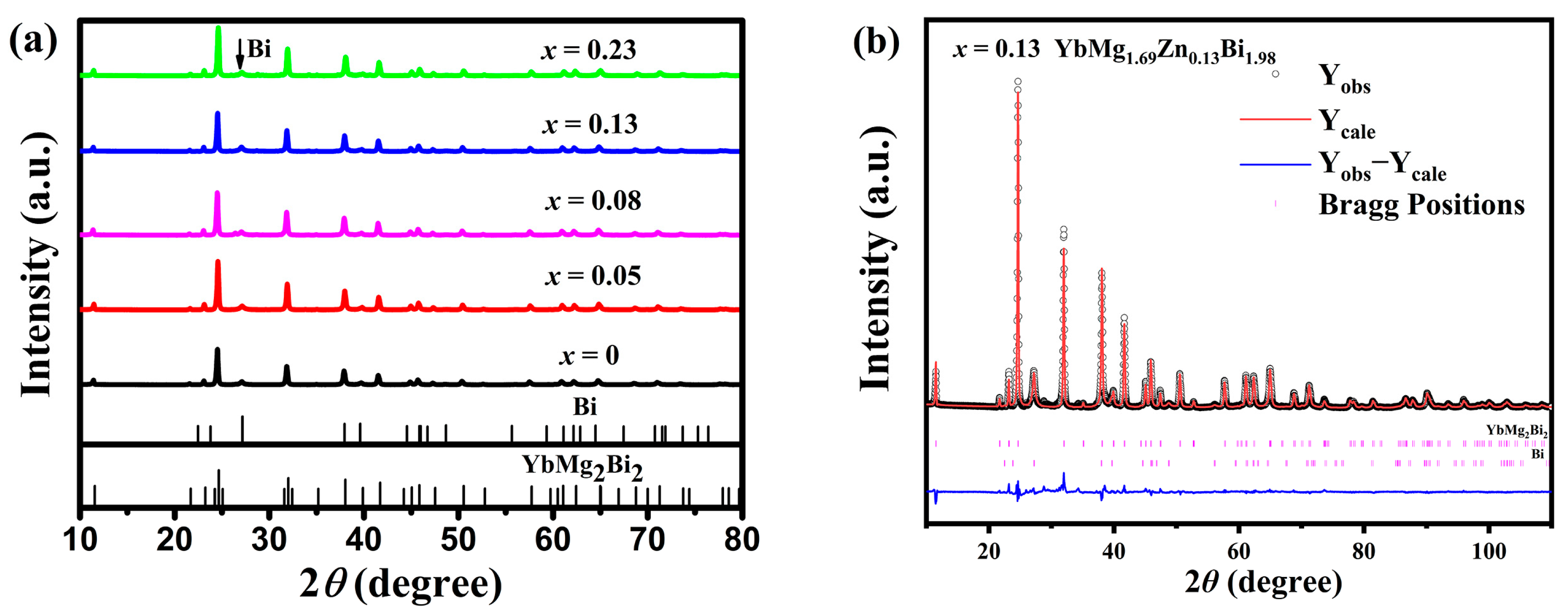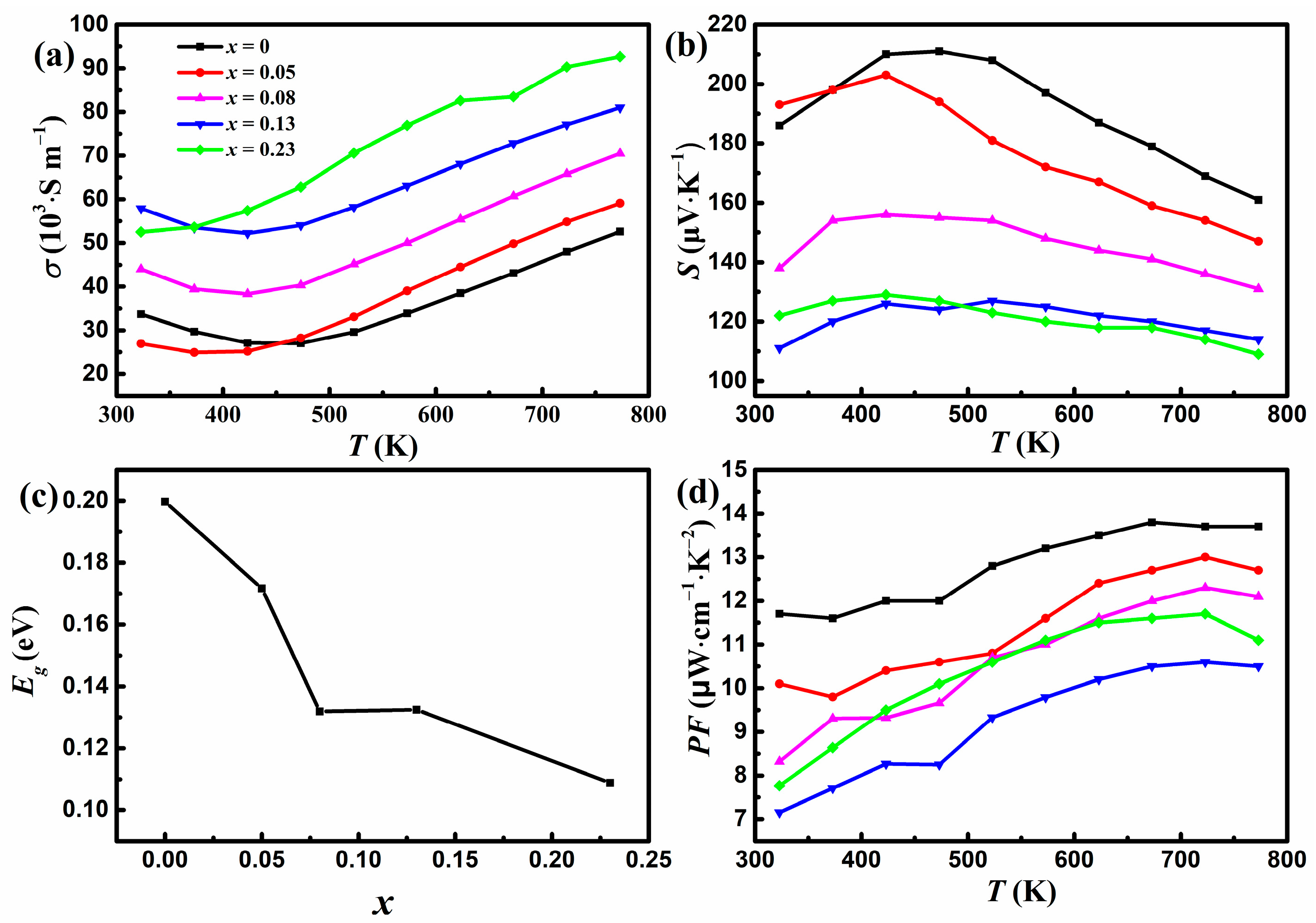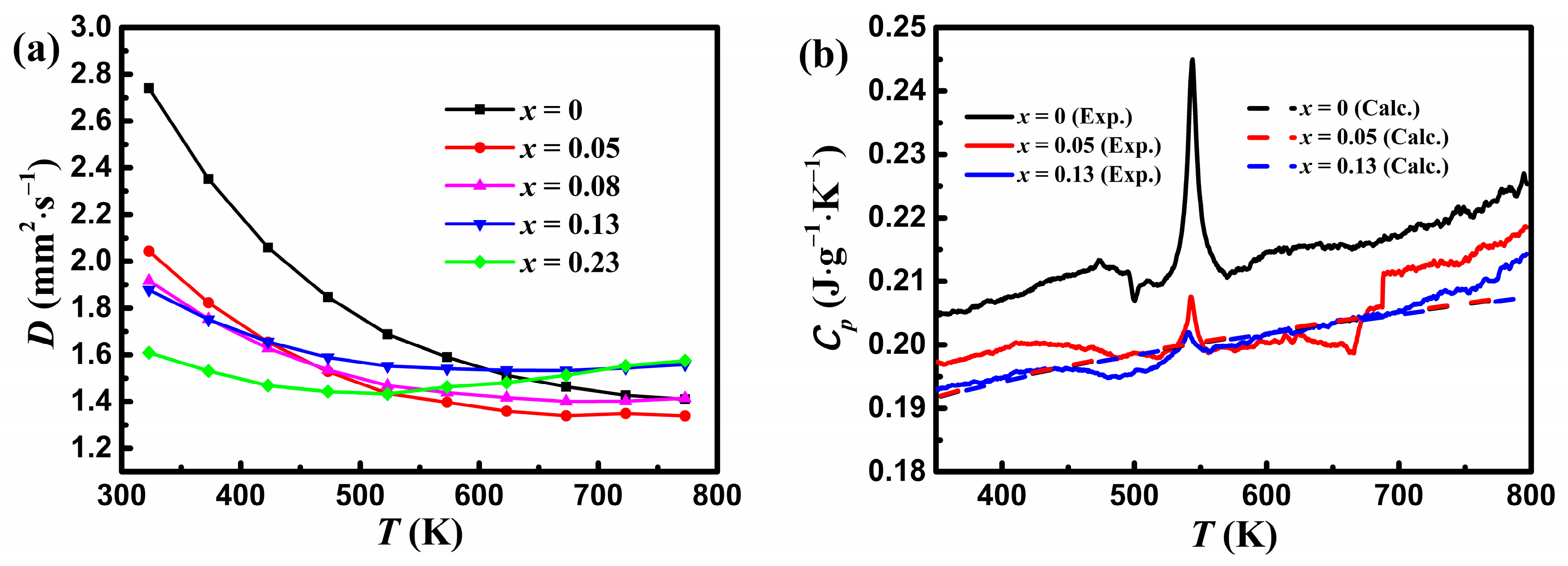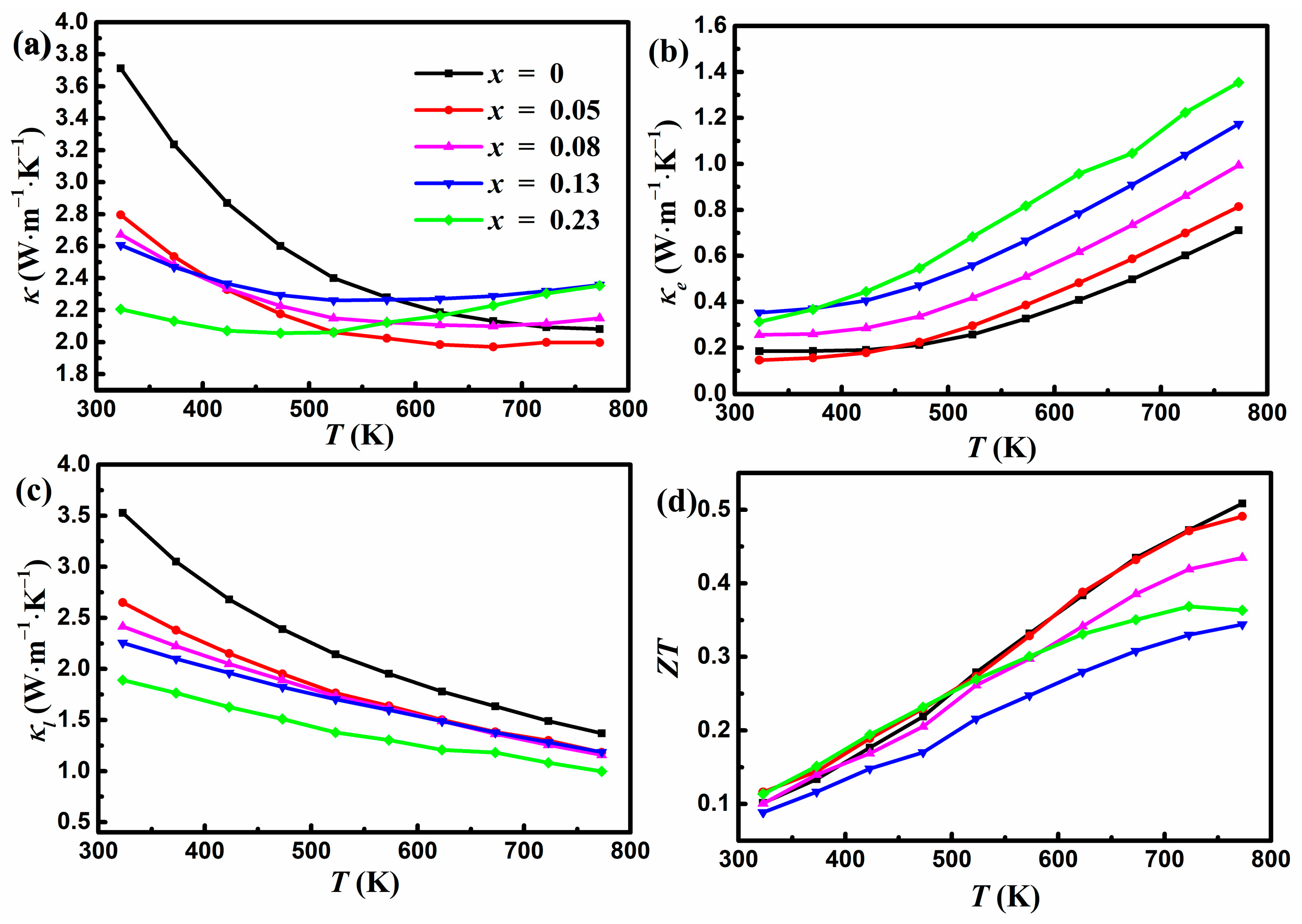Thermoelectric Properties of Zn-Doped YbMg1.85−xZnxBi1.98
Abstract
:1. Introduction
2. Materials and Methods
3. Results and Discussion
3.1. Phase Analysis
3.2. Electronic and Thermal Transport Properties
4. Conclusions
Author Contributions
Funding
Institutional Review Board Statement
Informed Consent Statement
Data Availability Statement
Conflicts of Interest
References
- d’Angelo, M.; Galassi, C.; Lecis, N. Thermoelectric Materials and Applications: A Review. Energies 2023, 16, 6409. [Google Scholar] [CrossRef]
- Mukherjee, M.; Srivastava, A.; Singh, A.K. Recent advances in designing thermoelectric materials. J. Mater. Chem. C 2022, 10, 12524–12555. [Google Scholar] [CrossRef]
- Dadhich, A.; Saminathan, M.; Kumari, K.; Perumal, S.; Rao, M.S.R.; Sethupathi, K. Physics and technology of thermoelectric materials and devices. J. Phys. D Appl. Phys. 2023, 56, 333001. [Google Scholar] [CrossRef]
- Wolf, M.; Hinterding, R.; Feldhoff, A. High Power Factor vs. High zT-A Review of Thermoelectric Materials for High-Temperature Application. Entropy 2019, 21, 1058. [Google Scholar] [CrossRef]
- Shuai, J.; Mao, J.; Song, S.; Zhang, Q.; Chen, G.; Ren, Z. Recent progress and future challenges on thermoelectric Zintl materials. Mater. Today Phys. 2017, 1, 74–95. [Google Scholar] [CrossRef]
- Kauzlarich, S.M.; Brown, S.R.; Snyder, G.J. Zintl phases for thermoelectric devices. Dalton Trans. 2007, 2099–2107. [Google Scholar] [CrossRef] [PubMed]
- Peng, W.; Chanakian, S.; Zevalkink, A. Crystal chemistry and thermoelectric transport of layered AM2X2 compounds. Inorg. Chem. Front. 2018, 5, 1744–1759. [Google Scholar] [CrossRef]
- Gascoin, F.; Ottensmann, S.; Stark, D.; Haïle, S.M.; Snyder, G.J. Zintl Phases as Thermoelectric Materials: Tuned Transport Properties of the Compounds CaxYb1−xZn2Sb2. Adv. Funct. Mater. 2005, 15, 1860–1864. [Google Scholar] [CrossRef]
- Zeier, W.G.; Zevalkink, A.; Gibbs, Z.M.; Hautier, G.; Kanatzidis, M.G.; Snyder, G.J. Thinking Like a Chemist: Intuition in Thermoelectric Materials. Angew. Chem. Int. Ed. 2016, 55, 6826–6841. [Google Scholar] [CrossRef]
- Imasato, K.; Wood, M.; Anand, S.; Kuo, J.J.; Snyder, G.J. Understanding the High Thermoelectric Performance of Mg3Sb2-Mg3Bi2 Alloys. Adv. Energy Sustain. Res. 2022, 3, 2100208. [Google Scholar] [CrossRef]
- Wang, X.-J.; Tang, M.-B.; Chen, H.-H.; Yang, X.-X.; Zhao, J.-T.; Burkhardt, U.; Grin, Y. Synthesis and high thermoelectric efficiency of Zintl phase YbCd2−xZnxSb2. Appl. Phys. Lett. 2009, 94, 092106. [Google Scholar] [CrossRef]
- Tiadi, M.; Trivedi, V.; Kumar, S.; Jain, P.K.; Yadav, S.K.; Gopalan, R.; Satapathy, D.K.; Battabyal, M. Enhanced Thermoelectric Efficiency in P-Type Mg3Sb2: Role of Monovalent Atoms Codoping at Mg sites. ACS Appl. Mater. Interfaces 2023, 15, 20175–20190. [Google Scholar] [CrossRef] [PubMed]
- Takagiwa, Y.; Sato, Y.; Zevalkink, A.; Kanazawa, I.; Kimura, K.; Isoda, Y.; Shinohara, Y. Thermoelectric properties of EuZn2Sb2 Zintl compounds: zT enhancement through Yb substitution for Eu. J. Alloys Compd. 2017, 703, 73–79. [Google Scholar] [CrossRef]
- Beretta, D.; Neophytou, N.; Hodges, J.M.; Kanatzidis, M.G.; Narducci, D.; Martin-Gonzalez, M.; Beekman, M.; Balke, B.; Cerretti, G.; Tremel, W.; et al. Thermoelectrics: From history, a window to the future. Mater. Sci. Eng. R 2019, 138, 100501. [Google Scholar] [CrossRef]
- Wood, M.; Aydemir, U.; Ohno, S.; Snyder, G.J. Observation of valence band crossing: The thermoelectric properties of CaZn2Sb2–CaMg2Sb2 solid solution. J. Mater. Chem. A 2018, 6, 9437–9444. [Google Scholar] [CrossRef]
- Guo, M.; Liu, M.; Zhu, J.; Zhu, Y.; Guo, F.; Cai, W.; Zhang, Y.; Zhang, Q.; Sui, J. Mechanism of Thermoelectric Performance Enhancement in CaMg2Bi2-Based Materials with Different Cation Site Doping. Small 2024, 20, 2306251. [Google Scholar] [CrossRef]
- Saparamadu, U.; Tan, X.; Sun, J.; Ren, Z.; Song, S.; Singh, D.J.; Shuai, J.; Jiang, J.; Ren, Z. Achieving high-performance p-type SmMg2Bi2 thermoelectric materials through band engineering and alloying effects. J. Mater. Chem. A 2020, 8, 15760–15766. [Google Scholar] [CrossRef]
- Shuai, J.; Geng, H.; Lan, Y.; Zhu, Z.; Wang, C.; Liu, Z.; Bao, J.; Chu, C.W.; Sui, J.; Ren, Z. Higher thermoelectric performance of Zintl phases (Eu0.5Yb0.5)1−xCaxMg2Bi2 by band engineering and strain fluctuation. Proc. Natl. Acad. Sci. USA 2016, 113, E4125–E4132. [Google Scholar] [CrossRef]
- Imasato, K.; Kang, S.D.; Ohno, S.; Snyder, G.J. Band engineering in Mg3Sb2 by alloying with Mg3Bi2 for enhanced thermoelectric performance. Mater. Horiz. 2018, 5, 59–64. [Google Scholar] [CrossRef]
- Zhou, T.; Song, J.; Lei, X.; Zhang, Q.; Bi, J.; Gao, D.; Jiang, J.; Wang, C. Achieving n-type conduction in YbMg2Sb2-based compounds through defect engineering and doping. Acta Mater. 2022, 223, 117467. [Google Scholar] [CrossRef]
- Zhang, X.; Gu, H.; Zhang, Y.; Guo, L.; Yang, J.; Luo, S.; Lu, X.; Chen, K.; Chai, H.; Wang, G.; et al. Enhanced thermoelectric properties of YbZn2Sb2−xBix through a synergistic effect via Bi-doping. Chem. Eng. J. 2019, 374, 589–595. [Google Scholar] [CrossRef]
- May, A.F.; McGuire, M.A.; Singh, D.J.; Ma, J.; Delaire, O.; Huq, A.; Cai, W.; Wang, H. Thermoelectric transport properties of CaMg2Bi2, EuMg2Bi2, and YbMg2Bi2. Phys. Rev. B 2012, 85, 035202. [Google Scholar] [CrossRef]
- Shuai, J.; Liu, Z.; Kim, H.S.; Wang, Y.; Mao, J.; He, R.; Sui, J.; Ren, Z. Thermoelectric properties of Bi-based Zintl compounds Ca1−xYbxMg2Bi2. J. Mater. Chem. A 2016, 4, 4312–4320. [Google Scholar] [CrossRef]
- Liang, Z.; Shang, H.; Xu, C.; Shi, X.; Zhang, F.; Ren, W.; Song, S.; Ding, F.; Ren, Z. New insights into the effect of chemical bonding strength on thermoelectric performance and stability in YbMg2Bi2 toward practical thermoelectric applications. Mater. Today Phys. 2022, 28, 100858. [Google Scholar] [CrossRef]
- Guo, M.; Guo, F.; Zhu, J.; Yin, L.; Qin, H.; Zhang, Q.; Cai, W.; Sui, J. Enhanced Thermoelectric Properties of p-Type CaMg2Bi2 via a Synergistic Effect Originated from Zn and Alkali-Metal Co-doping. ACS Appl. Mater. Interfaces 2020, 12, 6015–6021. [Google Scholar] [CrossRef]
- Yang, X.; Gu, Y.; Li, Y.; Guo, K.; Zhang, J.; Zhao, J.-T. The equivalent and aliovalent dopants boosting the thermoelectric properties of YbMg2Sb2. Sci. China Mater. 2020, 63, 437–443. [Google Scholar] [CrossRef]
- Guo, M.; Zhu, J.; Guo, F.; Zhang, Q.; Cai, W.; Sui, J. Enhanced thermoelectric performance of P-type CaMg2Bi1.98 and optimized CaAl2Si2-type Zintl phase module with equal cross-section area. Mater. Today Phys. 2020, 15, 100270. [Google Scholar] [CrossRef]
- Rodríguez-Carvajal, J. Recent advances in magnetic structure determination by neutron powder diffraction. Physica B 1993, 192, 55–69. [Google Scholar] [CrossRef]
- Agne, M.T.; Imasato, K.; Anand, S.; Lee, K.; Bux, S.K.; Zevalkink, A.; Rettie, A.J.E.; Chung, D.Y.; Kanatzidis, M.G.; Snyder, G.J. Heat capacity of Mg3Sb2, Mg3Bi2, and their alloys at high temperature. Mater. Today Phys. 2018, 6, 83–88. [Google Scholar] [CrossRef]
- May, A.F.; McGuire, M.A.; Singh, D.J.; Custelcean, R.; Jellison, G.E., Jr. Structure and properties of single crystalline CaMg2Bi2, EuMg2Bi2, and YbMg2Bi2. Inorg. Chem. 2011, 50, 11127–11133. [Google Scholar] [CrossRef] [PubMed]
- Ramirez, D.; Gallagher, A.; Baumbach, R.; Siegrist, T. Synthesis and characterization of the divalent samarium Zintl-phases SmMg2Bi2 and SmMg2Sb2. J. Solid State Chem. 2015, 231, 217–222. [Google Scholar] [CrossRef]
- Pauling, L. Atomic Radii and Interatomic Distances in Metals. J. Am. Chem. Soc. 1947, 69, 542–553. [Google Scholar] [CrossRef]
- Goldsmid, H.J.; Sharp, J.W. Estimation of the thermal band gap of a semiconductor from seebeck measurements. J. Electron. Mater. 1999, 28, 869–872. [Google Scholar] [CrossRef]
- Bardeen, J.; Shockley, W. Deformation Potentials and Mobilities in Non-Polar Crystals. Phys. Rev. 1950, 80, 72–80. [Google Scholar] [CrossRef]
- Zhou, T.; Jiang, J.; Wang, C. Enhancement of thermoelectric performance of YbMg2Bi2-based materials by alloying and doping with suppressed bipolar effect. IOP Conf. Ser. Earth Environ. Sci. 2020, 467, 012023. [Google Scholar] [CrossRef]
- Pakhira, S.; Tanatar, M.A.; Johnston, D.C. Magnetic, thermal, and electronic-transport properties of EuMg2Bi2 single crystals. Phys. Rev. B 2020, 101, 214407. [Google Scholar] [CrossRef]
- Kim, H.-S.; Gibbs, Z.M.; Tang, Y.; Wang, H.; Snyder, G.J. Characterization of Lorenz number with Seebeck coefficient measurement. APL Mater. 2015, 3, 041506. [Google Scholar] [CrossRef]
- Morelli, D.T.; Jovovic, V.; Heremans, J.P. Intrinsically minimal thermal conductivity in cubic I-V-VI2 semiconductors. Phys. Rev. Lett. 2008, 101, 035901. [Google Scholar] [CrossRef] [PubMed]
- Callaway, J. Model for Lattice Thermal Conductivity at Low Temperatures. Phys. Rev. 1959, 113, 1046–1051. [Google Scholar] [CrossRef]





| x = 0 | x = 0.05 | x = 0.08 | x = 0.13 | x = 0.23 | |
|---|---|---|---|---|---|
| a (Å) | 4.7341 (1) | 4.7309 (2) | 4.7264 (1) | 4.7240 (1) | 4.7145 (2) |
| c (Å) | 7.6717 (2) | 7.6717 (3) | 7.6689 (3) | 7.6675 (3) | 7.6626 (3) |
| V (Å3) | 148.901 (7) | 148.70 (1) | 148.360 (9) | 148.187 (9) | 147.492 (10) |
| Occ. Mg/Zn | 0.925/0 | 0.875/0.025 | 0.885/0.04 | 0.845/0.065 | 0.815/0.115 |
| zMg/Zn | 0.6268 (8) | 0.6281 (11) | 0.6261 (10) | 0.6248 (10) | 0.6247 (9) |
| zBi | 0.2441(2) | 0.2461 (2) | 0.2447 (2) | 0.2458 (2) | 0.2457 (2) |
| ρ122 (g/cm3) a | 7.208 | 6.983 | 6.985 | 7.032 | 6.959 |
| ρBi (g/cm3) b | 9.814 | 9.824 | 9.802 | 9.827 | 9.819 |
| m122/Bi (wt. %) | 85.3/14.7 | 89.3/10.7 | 83.6/16.4 | 82.6/17.4 | 88.3/11.7 |
| Exp. d (g/cm3) c | 7.130 | 7.197 | 7.271 | 7.314 | 7.159 |
| % T. D. | 95.1 | 99.9 | 99.2 | 98.8 | 99.4 |
| Rp (%) | 8.91 | 12.1 | 10.8 | 11.4 | 11.6 |
| Rwp (%) | 11.9 | 17.1 | 15.4 | 15.9 | 17.2 |
| Rexp (%) | 3.79 | 3.20 | 3.41 | 3.65 | 3.30 |
Disclaimer/Publisher’s Note: The statements, opinions and data contained in all publications are solely those of the individual author(s) and contributor(s) and not of MDPI and/or the editor(s). MDPI and/or the editor(s) disclaim responsibility for any injury to people or property resulting from any ideas, methods, instructions or products referred to in the content. |
© 2024 by the authors. Licensee MDPI, Basel, Switzerland. This article is an open access article distributed under the terms and conditions of the Creative Commons Attribution (CC BY) license (https://creativecommons.org/licenses/by/4.0/).
Share and Cite
Wei, S.; Qin, N.; Wu, G.; Xu, Z.; Miao, L.; Chen, X.; Yan, J. Thermoelectric Properties of Zn-Doped YbMg1.85−xZnxBi1.98. Materials 2024, 17, 973. https://doi.org/10.3390/ma17050973
Wei S, Qin N, Wu G, Xu Z, Miao L, Chen X, Yan J. Thermoelectric Properties of Zn-Doped YbMg1.85−xZnxBi1.98. Materials. 2024; 17(5):973. https://doi.org/10.3390/ma17050973
Chicago/Turabian StyleWei, Simin, Nailing Qin, Guiying Wu, Zhengbing Xu, Lei Miao, Xiyong Chen, and Jialin Yan. 2024. "Thermoelectric Properties of Zn-Doped YbMg1.85−xZnxBi1.98" Materials 17, no. 5: 973. https://doi.org/10.3390/ma17050973





